| Published
on 20
Oct
2012 |
All rights reserved.
|
|
|
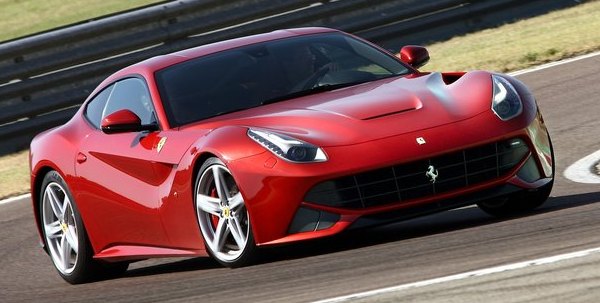 |
|
Ferrari's
flagship V12 tries to steal the limelight from its mid-engined sisters
again.
|
|
Since the days of F355,
Ferrari's 12-cylinder flagship line has been struggling to convince
customers that it provides better performance and handling than the
mid-engined V8 line. The F512M failed to do so. Ditto 550 Maranello and
575M. Saviour came in the form of 599GTB some six years ago. Not only
providing GT comfort and user friendliness, it demonstrated better
balance and body control than the contemporary F430, not to mention the
superior power and smoothness brought by its V12 engine. As a result,
we declared it the best driving Ferrari of the time.
However, the balance tipped to the mid-engined camp again with the
launch of 458 Italia. This is truly a landmark creation, lifting speed,
handling and driving thrills to unprecedented levels. Its sexy body
also makes the 599 a bit dull and old-fashioned. The special edition
599GTO struck back in 2010, but the flagship line no longer enjoyed a
superior image. It is time for a full upgrade.
So here comes the new F12 Berlinetta. Its name does not come from any
existing nomenclatures of Maranello – the F stands for Ferrari, while
12 is the number of different grades of aluminum its chassis employed.
No matter for engineering, performance or driving thrills, the progress
it has taken from 599 is comparable to the evolution from F430 to 458,
which means huge. Therefore it has a good chance to take back the crown
again.
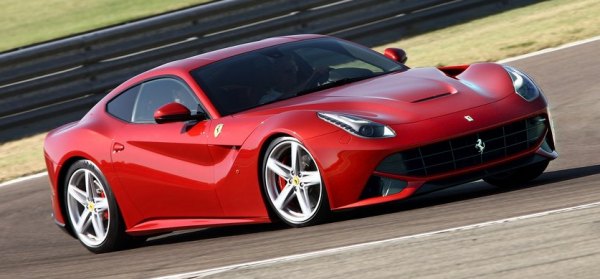 |
|
The
progress it has taken from 599 is comparable to the evolution from F430
to 458, which means huge.
|
|
Chassis and Body
Compare with its predecessor, the F12 is made more compact. We won't
call it small, but the fact that it is 47 mm shorter, 18 mm narrower
and runs a 30 mm shorter wheelbase is encouraging news following so
many years of growth. The smaller size, in addition to the use of
different grades of aluminum parts for the construction of its
spaceframe chassis allows Ferrari to cut 60 kilograms from the final
kerb weight while lifting torsional rigidity by 20 percent. At 1525 kg
dry, the F12 is 50 kilos lighter than the Lamborghini Aventador with
carbon-fiber chassis, although the Lambo does sports four-wheel drive
hardware. Ferrari proves that aluminum chassis is still viable on
"production" supercars.
Even more important is how the weight is distributed. If you admire the
599's front-to-rear balance of 47:53, you must adore the new car's
46:54, which is incredible for a front-engined machine. The one percent
of extra weight acted on its rear wheels should improve traction
further, while less weight over the front axle should improve turn-in
response. Equally important is the center of gravity. Thanks to
lowering the roof by a massive 62 mm (the F12 is even lower than the
low-looking 550M), mount the V12 engine 30 mm closer to the ground as
well as lowering the dashboard and seats altogether, its center of
gravity is 25 mm lower than that of its predecessor. This benefits
cornering stability.
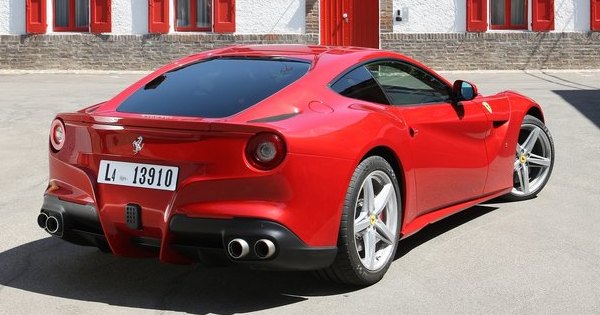 |
|
If
you admire the 599's front-to-rear balance of 47:53, you must adore the
new car's 46:54, which is incredible for a front-engined machine.
|
|
The F12 excels in aerodynamics, too. Its drag coefficient is
significantly improved from 0.336 to 0.299, which is excellent for a
supercar. A couple of aerodynamic aids contribute to that improvement:
1) Aero Bridge channels air from above the bonnet towards the sides,
interacting with the turbulence from the front wheels to reduce drag;
2) Active Brake Cooling closes the front brake cooling intakes normally
to reduce drag and opens only when the brakes get too hot. Downforce is
also its strength. Brilliantly, without resorting to a standalone or
pop-up rear spoiler, the F12's improved shape and large under-floor
diffusers manage to generate 123 kg of downforce at 124 mph (200km/h).
Regarding styling, I am leaving it to you to make your own judgment.
However, most people agree that it looks sharper and sexier than the
599, if not the most beautiful shape Ferrari and Pininfarina had
created.
Engine, transmission
and performance
The 6262 cc direct-injected V12 is a derivative of the one serving
Ferrari FF. It runs a super-high compression ratio of 13.5:1, compare
to the FF's 12.3:1, along with freer intake manifolds and exhaust and
faster cam timing. Titanium connecting rods are reserved for the
possible GTO version in the future, but this production engine is still
capable of revving to 8700 rpm, 300 rpm higher than 599GTB and 200
higher than Lamborghini Aventador. This eagerness for rev is partly
contributed by its oversquare combustion chambers with 94 mm bore and
75.2 mm stroke.
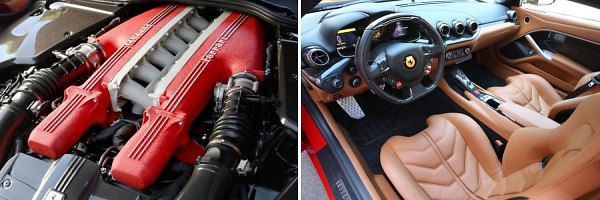 |
|
The
motor pumps out 740hp, a new height for Ferrari road cars – actually
matching today's Formula 1 V8 engines!
|
|
At 8250 rpm, the motor pumps out an
astonishing 740 horsepower, a new
height for Ferrari road cars – actually matching today's Formula 1 V8
engines! That figure translates to an impressive specific output of 118
horsepower per liter. The new V12 is not only 120 hp more powerful than
its predecessor (or 70 hp more than GTO) but also surpasses Lamborghini
Aventador by 40 hp, despite of less capacity. Its maximum torque is 509
pound-foot. 80 percent of which is available from 2500 rpm, so
excellent tractability is guaranteed.
As previewed by the FF, the rear-mounted transaxle has switched from
the outgoing 6-speed F1 automated manual gearbox to a 7-speed
twin-clutch gearbox jointly developed with Getrag.
Ferrari claims the car tops more than 340 km/h or 211 mph, while 0-60
mph sprint takes 3 seconds flat. The latter might not match the
4-wheel-drive Aventador, but more important is it takes only 8.5
seconds to do 0-124 mph, nearly a second quicker than the big Lambo.
Judging by acceleration, it is the fastest Ferrari road car ever.
Judging by lap time on Ferrari's own Fiorano test track, it is also the
fastest. With a time of 1 minute and 23 seconds, it beats 599GTB by 3.5
seconds, Enzo and 458 Italia by 2 seconds, and 599GTO by one second.
And this is just the beginning of its development...
Meanwhile, the car also gets greener. Thanks to the new gearbox and
automatic engine stop-start system (which has a silly name: HELE, or
High Emotion, Low Emission), the F12 Berlinetta has its fuel economy
improved from 15.8 to 18.8 mpg. Carbon-dioxide emission is reduced by
16 percent to 350 g/km.
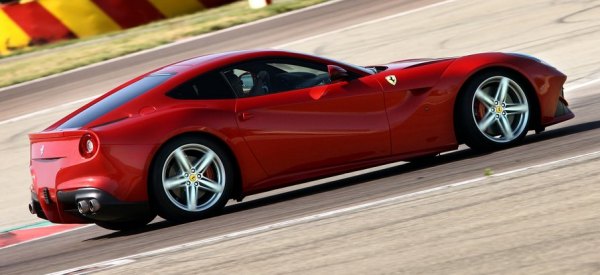 |
|
It
takes only 8.5 seconds to do 0-124 mph, nearly a second quicker than
the big Lambo.
|
|
Suspensions and electronics
Like FF, the F12 rides on double-wishbones suspensions up front and a
new 5-link axle at the rear. The latest generation of
magnetorheological adaptive damping gains secondary coils for quicker
response while generate less friction. New gen carbon-ceramic brakes
(CCM3) are also said to be improved. Apart from the carried-over
F1-Trac traction control, the new E-Diff electronic-controlled active
differential should be able to regulate the torque split between left
and right rear wheels more precisely and responsively than those
brake-actuated torque vectoring systems. This must be a big advantage
over the 599.
On the Road
Climb aboard, the environment should be familiar to the owners of
recent Ferraris. The mix and match of carbon-fiber trims, leather,
plastic, alloy and circular air vents may be not as tasteful as Aston
Martin Vanquish or Pagani Huayra, but this place is unquestionably
spacious, comfortable and functional. Despite of the downsize, the F12
offers the same excellent accommodation for 2 tall drivers and an even
larger, 500-liter boot under the hatchback door. The driving position
and seats are superb. Visibility is excellent for a supercar. You
rarely need to distraction attention from the instrument because sat
nav and infotainment system are displayed at the TFT screens
sandwiching the center rev counter, all located within the instrument
binnacle. Most frequently used buttons are found on the
Playstation-style steering wheel, including the famous Manettino rotary
switch which gives access to 5 driving modes – Wet, Sport, Race,
Traction Control Off and Stability Control Off. Similarly, gearshift
paddles mounted at the steering column ease your hard work and keep
your concentration to the road, even though I still miss the aluminum
ball gear knob of older Ferraris. It goes without saying that Ferrari
pioneered this design 15 years ago on F355. I doubt any other supercars
could serve the need of hardcore drivers as good as Ferrari.
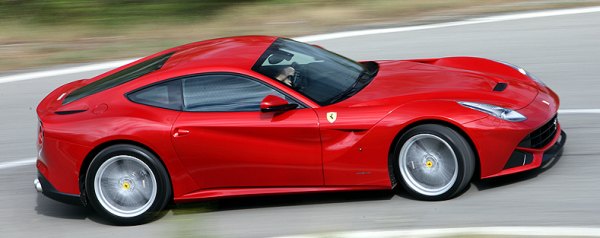 |
|
You
are not served with the ugly wastegate whoosh of its turbocharged
rivals, but a neverending high-pitch mechanical noise that only an
Italian V12 or Formula One engine can produce!
|
|
Press the Start button on the steering wheel, the mighty V12
bursts into live. Just as you would expect for a Ferrari V12, it is
incredibly smooth, free-revving and soulful. There seems to be little
inertia to overcome. It responds instantly to your throttle input,
rewards your prod with angry barks. Engage the first gear, guide it to
the motorway and start exploring its deep reserves, you will be shocked
with its new found performance – the acceleration is so strong and
seamless (thanks to the dual-clutch gearbox) that it can easily eclipse
McLaren F1. Well, the g-force is not as exaggerate as Bugatti Veyron or
a Pagani Huayra under full boost, but the driving experience is no less
breathtaking. Better still, you are not served with the ugly wastegate
whoosh of its turbocharged rivals, but a neverending high-pitch
mechanical noise that only an Italian V12 or Formula One engines can
produce! At lower rev the cabin is dominated by creamy induction noise.
As rev rise it gradually gives way to the exhaust noise, which gets
increasingly intense and eventually goes mad beyond 8000 rpm. This is a
noise every supercar should possess!
Storm the car through some mountain roads and you will realize its
dual-personality. On the one hand, it is a decent grand tourer. Apart
from the cabin space and luggage capacity it offers, it is comfortable
for covering long distances. The ride in the softest suspension setting
is absorbent enough. The gearbox in auto mode shifts smoothly. The
engine noise is well checked at normal cruising speed. The clever
traction and stability control masks the beast side of the car
remarkably well, always keeping it running on the desired path. The
electronic intervention is so subtle that sometimes you might forget
that you are driving a supercar with 740 hp running through its rear
tires.
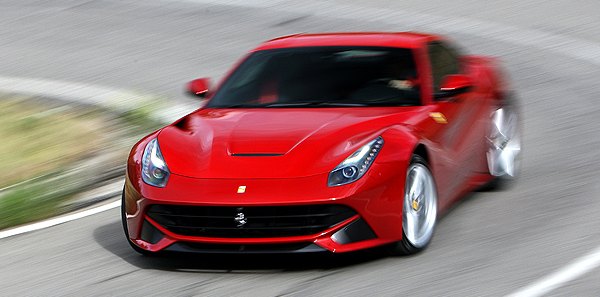 |
|
On
the one hand, it is a decent grand tourer. On the other hand, it
possesses sports car sharpness and communication.
|
|
On the other hand, the F12 possesses sports car sharpness
and communication. Its hydraulic-assisted steering is not only feelsome
but also very direct – actually, it uses the same 2.0 turns
lock-to-lock gearing ratio as the 458. Traditionalists might regard
that to be too quick to the extent of nervous, but recalibrate your
mind and you will find the new rack makes the F12 feels incredibly
small and responsive compare with its predecessors. Tight cornering
needs no more than a small flick of the steering wheel, and a tiny
counter steer can kick its tail out, so handy! The shorter wheelbase
and active differential also enhance its sense of agility a lot. The
immense grip and traction give you maximum confidence to attack corners
at speeds well beyond the capability of 599, GTO included. The ceramic
brakes are not only monstrously powerful but also give excellent feel.
The F12 feels more like a lighter mid-engined sports car!
Ultimately, it is not as sporty as the marvelous 458, which feels a
touch sharper to steer and rolls less in corner. With ESP and F1-Trac
completely switched off, the F12 could reveal its temper should you
abuse its ultra-quick steering in a bend. It will respond with big
oversteer. After all, this car has more punch than Aventador yet it
relies on rear tires only to put down the power.
I would still pick 458 as my favourite sports car of all, but if you
need a supercar that combines sports car excitement and GT comfort, the
F12 Berlinetta is the best of the bunch. It might lack Lamborghini's
sense of occasion, but it is actually faster on the road, more soulful
to drive and far more practical to use everyday.
|
Verdict:      |
| Published
on 28
Nov
2015 |
All rights reserved.
|
|
F12tdf
|
|
 |
|
The
F12tdf is clearly oriented to race tracks, more so than 458 Speicale or
its precedessor 599GTO...
|
|
It is hard to imagine how
Ferrari F12 Berlinetta could be improved further on performance and
handling. This car is right at the limit of a front-engined rear-drive
GT as its V12 produces an astonishing 740 horsepower, its twin-clutch
gearbox shifts lightning quick and its ultra-direct (2.0 turns lock to
lock) steering is fast to the extent of nearly nervous. Can it handle
even more power and sharper chassis tuning? I doubt, but will be glad
to see.
So this is it. F12tdf, whose suffix stands for Tour de France. If you
are familiar with the history of Ferrari you must remember the
legendary 250GT Tour de France,
a car that made Ferrari famous in the
1950s. The 3300-miles Tour de France race comprised of many hill climb
and rally stages, something I'm afraid the new car would fail to do.
The F12tdf is clearly oriented to race tracks, more so than 458
Speicale or its precedessor 599GTO. Its aggressive front splitter,
winglets and side skirts leave so little ground clearance. These aero
kits give it 230 kg of downforce at 200 km/h (124 mph), more than
double of the standard car. Also contribute to this remarkable
figure are the louvers opened at the rear wheel arches, which releases
air pressure built up within the wheel wells and by the way provide a
visual link to the classic 250 GTO. The larger and higher set rear
spoiler also generate more downforce. Thanks to a slower angle rear
screen and two recess channels either side of it, more air is channeled
towards the rear spoiler thus makes the latter even more effective.
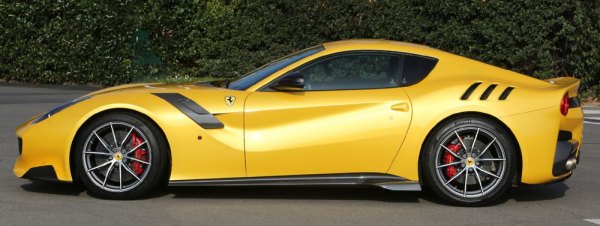 |
|
These
aero kits give it 230 kg of downforce at 200 km/h.
|
|
The 6.3-liter direct-injection V12, which already achieves a sky-high
specific output of 118 hp per liter in Berlinetta, is massaged
further in the Tdf. By using less restrictive airboxes, larger throttle
bodies and mechanical tappets instead of hydraulic ones, which cuts
inertia and increases valve lift a little, the new engine has its
redline lifted by 200 rpm to 8900 rpm. At 8500 rpm, it produces 780
horsepower, 40 more than before. By the way, it surpasses Aston Martin
One-77 to be the most powerful FR car in the world, despite the fact
that its engine is a full liter smaller. Don’t think these aggressive
tuning would hamper its low-end tractability. Ferrari has introduced a
new variable
trumpet system to alter the effective length of intake
manifolds according to rev. As a result, the V12 still offers 80
percent of its max. torque from as low as 2500 rpm. Meanwhile, the peak
torque is improved slightly to 520 lbft at 6750 rpm.
To aid acceleration further, the 7-speed twin-clutch transaxle is given
6% shorter ratios and remapped for faster gearshifts, i.e. 30% quicker
on upshifts and 40% quicker on downshifts. Consequently, the official
0-60 mph time is reduced by a couple of tenths to 2.8 seconds. 0-124
mph is cut by 0.6 seconds to 7.9 seconds (that's 0.4 sec faster than
488 GTB). Top speed is unchanged at 211 mph-plus.
The special edition also trims 110 kg of fat, thanks in part to the
smaller rear window and rear quarter windows as well as more use of
carbon-fiber inside and outside, such as the doors. As expected, the
interior gets more spartan. Leather trims are replaced with Alcantara
while carpets and glovebox are deleted. The door panels become bare
carbon-fiber, ditto the instrument pod. However, air-con and sat-nav
are intact, as rich buyers could no longer live without them.
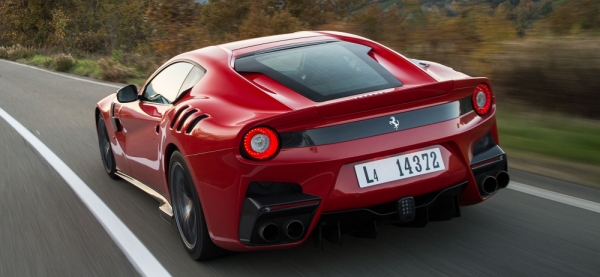 |
|
Ferrari
deliberately uses wider front tires to induce oversteer. At the same
time, it introduces a rear-wheel steering to tame the otherwise nervous
handling.
|
|
However, the most influential change is not weight saving but the
philosophy of its chassis tuning. The tdf has its Pirelli P-Zero Corsa
front rubbers widened by 20 mm to 275/35ZR20. This is unusually wide
compared with the 315/35ZR20 rear tires. If you have studied the
Handling section of our Technical School, you may know the
wider the tire the less slip angle it produces. Furthermore, if
the slip angle of front tires is smaller than rear tires, the car
is prone to oversteer. In order to sharpen its handling, making it more
agile and more responsive to steering input, Ferrari deliberately uses
wider front tires to induce oversteer. At the same time, it introduces
a rear-wheel-steering system to tame the otherwise nervous handling.
This recalls my memory of X-29 experimental fighter jet (I was
enthusiastic with aircrafts, tanks, warships etc. in my childhood),
whose forward-swept wings were designed to be inherently unstable and
therefore agile, and it used computer to adjust the flaps repeatedly to
keep it stable in the air. The F12tdf is the same. Its rear wheels may
steer up to 2 degrees in the same direction as the front to counter the
oversteer. The adjustment works busily through corners, and Ferrari’s
control system is good enough to hide its intervention. As a result,
you only feel the car incredibly sharp and agile. The electromechanical
RWS hardware is supplied by ZF (same supplier as Porsche). It adds only
5 kg to the car.
The suspension of tdf gets 20 percent stiffer springs than the
Berlinetta, which should make it marginal for road use. Fortunately, it
retains the magnetorheological adaptive dampers. The braking system
gets more powerful, as the one-piece calipers come from LaFerrari.
Overall, the combination of more power, faster gearshift, lighter and
sharper chassis, more downforce and better brakes allows the F12tdf to
lap Fiorano track in 1:21, two seconds clear of the standard F12
and 488GTB. BTW, LaFerrari remains at the top with a lap time of
1:19.7.
On the Road
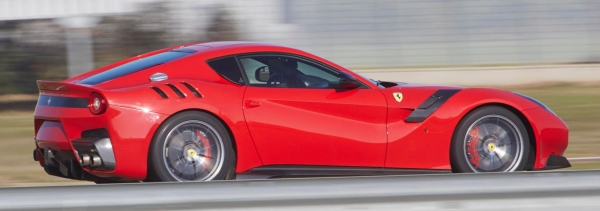 |
|
The
tdf is more precise, more responsive but less tolerable to errors...
|
|
When you drive the tdf on typical Italian country roads outside
Maranello, the differences from the standard car is immediately
noticeable. Its suspension feels quite a lot firmer. In Comfort mode
the ride quality is barely bearable. Other modes are best reserved for
the smoothest roads or race tracks. It seems to lack the dual-purpose
versatility of 458 Speciale, whereas the standard F12 is definitely a
better road car.
Likewise, the gearshift speed is so aggressive that you can feel its
hunger for race track victories. However, the V12 is marvelous. Its
response is ultra-fast, its noise is glorious, its endless rev and
elastic delivery are all peerless. Can you feel the extra 40 hp?
Probably not on the road as the standard car is already too powerful to
exploit, but you do feel the added sharpness of throttle response. In
fact, it is so sharp that some might feel nervous in the first
encounter.
The handling is a similar story. The tdf's steering is light, fast yet
swiss-watch precise. It doesn't understeer at all, just responds to
your steering input without hesitation. The standard F12 shares the
same ultra-quick steering, but its chassis allows a bit stablizing
understeer to absorb your over-reaction. In contrast, the tdf is more
precise, more responsive but less tolerable to errors. You have to be
delicate on throttle and steering to achieve the best results. If you
master that technique, you will find a machine very hard to be beaten
on tracks. Yes, it is more difficult to drive than most of the current
generation supercars, but it is also a car that rewards better drivers.
The more you drive it, the more you learn from it, and the more
satisfaction you get. It is not just a machine but a mate with strong
personality.
That’s why the car can stand proudly against the likes of Aventador SV
and even some more expensive supercars. At £340,000, it is a full
£100K more than the F12 Berlinetta. With a production volume of
799 units, it is not exactly rare (Sergio Marchionne is greedy). Still,
the F12tdf is special and worth the investment.
|
Verdict:     |
| Published
on 23
Jun
2017 |
All rights reserved.
|
|
812 Superfast
|
|

|
|
Does
it need more power? No, but Ferrari has to keep it ahead of Lamborghini
Aventador or the likes of McLaren 720S.
|
|
In the supercar business,
you cannot stop chasing more power and speed, or you will be
overshadowed by rivals and suddenly look like a thing of the past. Even
a car with a
bloodline as prestigious as Ferrari F12 faces the same pressure. The
F12 has been acclaimed for combining GT usability with supercar speed
and feel. Nothing in the front-engined world could match its straight
line speed, sharp throttle response, lightning steering, great balance
and well sorted at-the-limit handling. In fact, it made the following
F12tdf look over the top, too wild to be tamed by most drivers. What I
cannot imagine is how Ferrari could improve it further. Does it need
more power? No, but Ferrari has to do that in order to keep it ahead of
Lamborghini Aventador or some other cars entering the 700hp Club
recently, such as McLaren 720S. The result is a neat 800 horsepower,
which
explains the first digit of the new car’s name. The remaining is more
obvious – 12 cylinders and Superfast. Yes, superfast, no kidding.
The last time Ferrari used the Superfast name was more than 50 years
ago on the 500 Superfast.
Back then, Superfast meant 400 horsepower yet that was obviously
overstated. It also meant an overstated 174 mph top speed and 0-60 mph
time of 6 seconds. Today, the Superfast means a solid 211 mph and 0-60
mph in 2.8 seconds. Both cars might share the same format of FR and a
large V12, but their characters couldn’t be more different. The 500
Superfast was heavy, luxurious and comfort-biased. It was hopeless to
match a, say, 275GTB in corner. Enzo Ferrari created it just because he
wanted the money from wealthy American. In contrast, the 812 is as good
a super sports car as a GT, just like the F12. If you want comfort and
luxury, you can always choose a Bentley Continental Supersports or
Mercedes-AMG S63 or even Ferrari’s own GTC4 Lusso instead. These cars
offer more space, a more luxurious interior, lower noise levels and a
gentler ride. However, if you want the fastest and the most exciting GT
in the world, the 812 is a no brainer.

|
|
If
you want the fastest and the most exciting GT in the world, the 812 is
a no brainer.
|
|
Just like the usual mid-life evolutions created by Maranello, the 812
keeps the basic chassis of F12 unchanged but all of its aluminum body
panels have been reshaped. Its proportion remains as before, but the
body now sports more scoops and outlets to the extent of discomfort.
The new openings around the headlights and C-pillars have the design
integrity downgraded slightly. You will get used to it, but first
impression is that its predecessor looked a little better. That said, I
think the new front grille and the quad-taillights are more stylish
than the old items, so it is not all about bad news.
Predictably, those scoops are added for the sake of aerodynamics. Air
entering the intakes adjacent to the headlights blows out at the
outlets midway of the bonnet, generating air curtains that help guiding
the surrounding air flow. Likewise, the scoops under the C-pillars draw
air
towards the outlets located just behind the rear fenders, generating
airstreams in the interest for the overall aerodynamics. Meanwhile, the
new outlets behind the front wheels guide air up through the sculpted
channels at the body sides. At the back, a TDF-style higher ducktail
spoiler is adopted to enhance downforce. Under the flat floor there are
some adjustable aero devices. Up front, a pair of spring-loaded flaps
close automatically under air pressure at 124 mph, blocking the
diffusers and reducing drag. At the back, 3 electrical-operated flaps
do similar things to the rear diffusers. Overall, Ferrari said its drag
is reduced by 3-4 percent without affecting downforce. I would
trade such a slim improvement for a more stylish look though.

|
|
Drag
is reduced by 3-4 percent. I would trade such a slim improvement for a
more stylish look though.
|
|
Highlight is the new V12, enlarged from 6.3 to 6.5 liters thanks to
stretching the stroke from 75.2 to 78mm. Its bore remains at 94mm,
the maximum allowed by the block originally designed for the
6-liter Enzo. Its compression ratio inches up from 13.5 to 13.6:1. The
intake manifold is new, incorporating the TDF’s variable
intake trumpet
system. The direct injection system has its pressure increased from 200
to 350 bar, enabling finer atomization of fuel and multiple injections
in a cycle. The engine also gets larger valves, higher inlet valve lift
and revised cam timing. Despite the longer stroke, now the V12 revs 200
rpm higher to 8900 rpm! Its peak output is 60 horsepower more
than before as well as arch-rival Aventador S, now achieved at 8500 rpm
instead of 8250 rpm. Maximum torque is improved by 20 lbft to 529 lbft.
That is released at an even higher 7000 rpm, which sounds peaky, but it
just proves that the engine gets stronger at the top end rather than
weaker down the rev. In fact, at least 80 percent of the maximum torque
is available from 3500 rpm.
In a bid to sharpen
its acceleration further, Maranello has tightened its first 6 gear
ratios by 6 percent. The twin-clutch transaxle also gets
updated software for even faster shifts – 30 percent faster on upshift
and 40 percent quicker on downshift! It goes without saying it is still
one of the best DCTs in the world.
In the real world, the 812’s powertrain and performance are incredible.
Thanks to the shorter gearing, the V12 feels even sharper in response.
Yes, the throttle response is really razor-sharp – even compared with a
rival as great as Lamborghini’s V12. It is even more free-revving. The
power delivery is remarkably smooth and linear but its noise gets
madder and
madder above 6000 rpm. Its enthusiasm for rev is stronger than even a
911 GT3. The higher it revs, the more energetic it appears and the
angrier it screams. It sounds even madder than the F12! This is simply
the world’s best engine any money
can buy, but
sadly, it might be the last time before mating with electric motors.

|
|
This
is simply the world’s best engine any money can buy, but sadly, it
might be the last time before mating with electric motors.
|
|
Frankly, it is difficult to detect the additional performance on public
roads. The F12 was already on the very edge of road-going super GTs. It
is hard to imagine any more performance could be extracted from road
tires and under real world situation. The 0-60 mph time of 2.8 seconds
is limited by traction, of which the 812 doesn’t lack, but it will take
4-wheel drive or a change to mid-engine layout to take another leap. A
better indicator to its new found performance is 0-124 mph, which is
accomplished in 7.9 seconds. That is almost a second quicker than its
predecessor as well as Aventador S, and 4/10ths faster than a 488GTB!
The new McLaren 720S is a tenth faster still, but that is also a much
lighter car (1419 vs 1630kg). In the real world, the 812 feels just
astonishingly fast, so fast that you will never ask for more!
Speed is nothing
without control. Fortunately, the 812 controls its speed very well.
Changes to its chassis is not dramatic. It gets the TDF’s rear-wheel
steering hardware, which is linked to all the electronic driving aids
(i.e. active differential, SSC side slip control etc.), but here the
tuning is less aggressive than the TDF’s. The car’s handling is
therefore less edgy and less prone to oversteer at the limit, which is
good. Another important change is the steering, which is Ferrari’s
first electrical rack. Although it is not truly feelsome, it doesn’t
feel much different from the old car’s hydraulic rack. The steering is
still geared unusually quick, with only 2.0 turns from lock to lock.
Jumping straight from another car, you need some miles to recalibrate
your reaction to its lightning response. Once you get used to it, you
will appreciate its directness. It feels a tad heavier than before but
is still lighter than the steering on most supercars or GTs. That
doesn’t affect your confidence though, as its weighting varies
consistently to reflect the state of adhesion up front. Ferrari also
uses the electric motor to vary the feedback torque during oversteer,
so to help you apply counter lock more quickly. The best thing is, it
feels so natural that you don’t sense the electronic intervention at
all.

|
|
The
best thing is, it feels so natural that you don’t sense the electronic
intervention at all.
|
|
With the help of 4WS and electrical power steering, the car feels a tad
more agile and less nervous at the limit than the F12. On a twisty
track, the 812 might not be good enough to challenge the mid-engined
488, 720S or Ford GT. Its weight distribution (47:53) means less
traction can be extracted from its rear tires, and its Pirelli P Zero
rubbers are purely for road use, certainly not as grippy as the Corsa
or Cup 2 tires. However, this does not deny the Maranello flagship V12
from performing brilliantly on track. Despite the mad side of 800
horsepower, its linear delivery allows you to meter the slip angle
precisely in corner. Its SSC manages power slide and recover so
smartly. If you turn off the traction control, you can unlock the
potential of the car, and it will go sideways everywhere. But still its
inherent balance is great, and you can tame the car with delicate
control, which is great fun.
What makes the 812 Superfast better than the mid-engined cars is its
dual-purpose personality. While its suspension feels slightly stiffer
than those of 488 or 720S (partly because you sit closer to the rear
axle), it is still competent enough to handle mountain roads. In a more
relaxing drive, the engine note and tire noise are quite subdued. The
cabin is easily roomier than those cars and easier to access as well.
There is a parcel shelf behind the seats and a relatively large boot,
so cross-country journeys are easy. As before, it is a competent GT and
a supercar simultaneously. The negatives? £253,000 sounds a lot
for a front-engined car made of aluminum, and the styling – both
exterior and interior – should have been better resolved.
|
Verdict:      |
| Published
on 12
Nov
2021 |
All rights reserved.
|
|
812 Competizione
|
|

|
|
The
ultimate evolution of Ferrari's front-engined V12 GT?
|
|
Sometimes "limited edition"
is not that limited, but when it comes from Maranello, it is guaranteed
to sell out. The new 812 Competizione and its open-top version
Competizione A (A for Aperta) are limited to 999 and 599 units,
respectively. They cost an eye-watering £450,000 and
£510,000, almost double the prices of the 812 Superfast and GTS,
yet all cars had been sold before officially announced. Maranello
plans to start delivery from Q1 next year for the coupe and Q4 next
year for the roadster.
From its downforce-optimizing shape, the 812 Competizione is clearly
focused on track performance compared with the Superfast. In other
words, it is the successor of F12 tdf, a car praised for razor sharp
response but was also criticized for nervous handling. Aerodynamics
takes the center stage of the modifications. The front end gets deeper
and wider air splitters. The bonnet adds a full-width carbon-fiber
louvered outlets in the middle, so to release air pressure built inside
the wheel wells and improve downforce. Likewise, the rear features
extra vents behind the rear wheels. A larger (still fixed) rear spoiler
and a much larger diffuser – the latter is made possible by switching
to twin-rectangular exhausts and pushing them to the outer edges –
afford more downforce. The glass rear screen has been replaced with an
aluminum louvered panel, not just to save weight but also to enable the
fitment of vortex generators to add downforce, even though at the cost
of rearview (a rearview camera is therefore added as standard
equipment). Overall, the Competizione generates 80kg more downforce at
124 mph.
The V12 now revs to 9500 rpm and produces max power at 9250 rpm, 600
and 750 rpm higher than before. It is a new record for Ferrari’s
production engines, although still trailing the Cosworth V12s on Aston
Martin Valkyrie and Gordon Murray T.50. Peak output is raised by 30hp
to 830hp, another record for Ferrari’s road-going combustion engines,
but peak torque is down by 19 lbft to 510. What has Ferrari changed?
The most important is titanium con-rods, something not seen on any
Ferrari V12s since the 6.0-liter Enzo. They are 40 percent lighter than
steel ones, and that is why the new engine revs higher. Other changes
include a more compact intake manifold (although it keeps the variable
inlet length feature), revised fuel injection, the use of diamond-like
coating on piston pins and cam lobes, a crankshaft that is 3 percent
lighter, a higher flowing variable-displacement lubrication pump, less
viscous oil and the inevitable fitment of gasoline particulate filters.
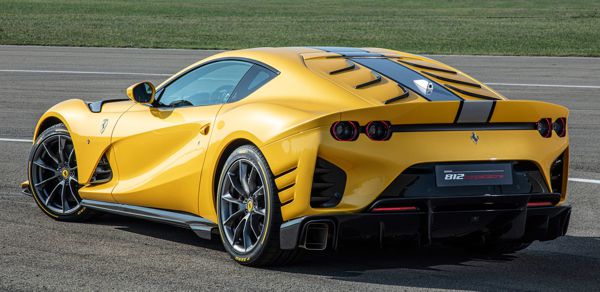
|
|
Unlike
F12 tdf, the rear axle now works in sync with the front.
|
|
The 7-speed twin-clutch gearbox is kept unchanged, but recalibrated
software results in 5 percent quicker shift times.
Meanwhile, the car underwent a diet, using carbon-fiber spoilers and
bumpers, a lithium battery and less sound deadening materials etc. to
trim 38kg from the dry weight. The suspension gets 50% stiffer springs
up front and 9% stiffer at the rear. Needless to say, the steering, SSC
and adaptive dampers are all retuned. The CCM brakes are carried over
from the standard car, but they are now cooled by dedicated air ducts.
In a straight line, the 812 Competizione is not too much faster than
the standard car – after all, Superfast is already superfast for a
front-engined GT. It is quoted the same top speed, while 0-60 and 0-124
mph are improved by only 0.05 and 0.4 seconds, respectively. The latter
takes 7.5 seconds, barely quicker than the mid-engined F8 Tributo by
0.3s, but slower than the newer 296GTB by 0.2s and the new flagship
SF90 by 0.8 second. This shows the classic format of FR layout + V12
power has probably arrived the end of the road. Although Ferrari would
not confirm, this car seems to be the run-out model of the 9-year-old
F12 family, and its successor is very likely to turn to hybrid power.
In order to tame the slightly nervous handling at the limit, the active
rear-wheel steering system is now able to steer the left and right rear
wheel at different angles. For example, under braking it will introduce
toe-in to aid stability. In tighter corners the outer wheel will steer
at a smaller angle than the inside wheel to improve turn-in response
and grip. This lets it make the best use of the grip available from the
optional Michelin PS Cup 2 R semi-slick rubbers.
Thanks to the calmer handling, the car can lap Ferrari’s Fiorano
circuit in 1:20, a second quicker than the F12 tdf, or just a second
adrift of the 1000-horsepower, all-wheel-drive and mid-engined SF90.
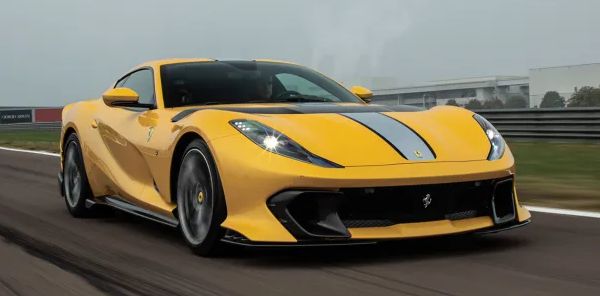
|
|
V12
revs to 9500 rpm, a new record for Maranello's road-going enignes.
|
|
In Fiorano – so far no motoring journalists have driven it on public
roads – the 812 Competizione performs superbly. The V12 motor remains
the highlight. While other Ferrari engines – now all turbocharged – are
renowned for response, they have no hope to match the V12’s razor-sharp
throttle response, the quick rise and fall of rev, the free-revving
manner and the smoothness. Although particulate filters have muffled
the exhaust noise a little, it remains the most exotic Ferrari
soundtrack. Launch the car at full throttle, the rev surges quicker
than your mind can keep up with. The gearbox upshifts in an eye blink,
resetting the rev needle and then it surges to the 9500 rpm redline
again… Maybe the acceleration isn’t as forceful as in a
1000-horsepower-plus turbocharged and electrified hypercar, the way it
delivers acceleration with a linear manner, mechanical feel and natural
acoustic is more satisfying and engaging, especially at the top end
where a tsunami of power and noises floods your mind.
As before, this Ferrari runs a very quick yet light steering, but it is
also accurate enough to inspire confidence. The fat front tires offer
tremendous front-end grip, enabling sharp turn-in. No matter how hard
you push, they just stick on the road and refuse to understeer. What it
really improves from the old car, especially tdf, is the rear axle.
Instead of giving up earlier than the front at the limit, it keeps
holding on. When it finally gives up, it does it progressively.
Therefore the car is not only quicker in corner but also feels calmer
and more predictable at the limit. It doesn’t provide as much traction
as Ferrari’s mid-engined cars, nor it controls its body roll as tightly
as the usual track machines like Porsche GT3 or McLaren 765LT, but the
812 Competizione has taken track handling of a front-engined car to a
new level – impossibly quick yet trustworthy enough. It is not exactly
fool-proof though. You still need to steer and throttle in a measured
way, especially when CT-off is enabled, but it is a great reward to
keen drivers.
Maybe adding a torque-vectoring electric front axle could give its
dynamics another dimension, but for purists, the 812 Competizione is
the ultimate evolution of a classic format that has been around
Maranello for more than 70 years. If Maranello’s pure combustion V12
line really bow out in this way, it would be sad, but I can’t think of
any better ways.
|
Verdict:      |
|